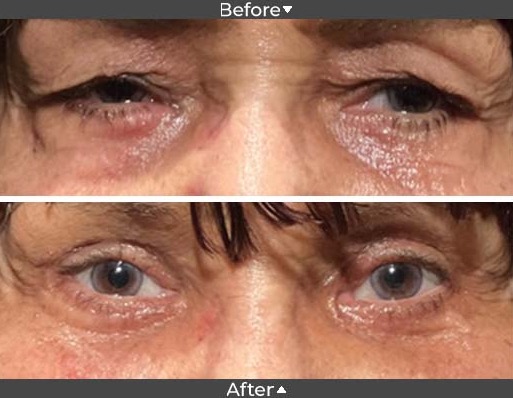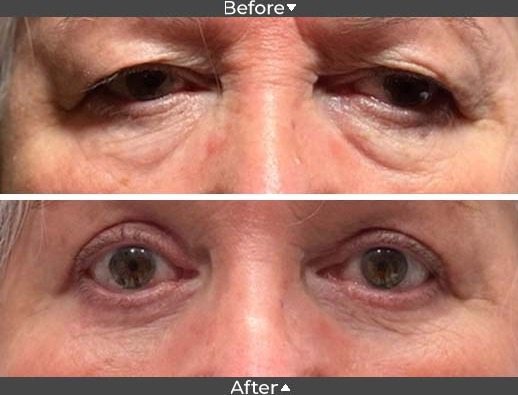
What is a blepharoplasty?
Blepharoplasty is a lower or upper eyelid surgery for rejuvenation, repair, or reconstruction.
Besides the aging process, severely sagging skin around the eyes can reduce side vision (peripheral vision), especially the upper and outer parts of the field of vision. Blepharoplasty can reduce or eliminate these visual problems. As a facial plastic surgery procedure, it can also make your eyes look younger and more alert.
A blepharoplasty helps erase one of the most noticeable signs of aging on your face, which is the area around your eyes. This procedure yields a significant improvement in your appearance.
- What can a blepharoplasty treat?
- Are there non-cometic (medical) reasons to have blepharoplasty?
- How popular are blepharoplasties?
- How is a blepharoplasty performed?
- What to expect after eyelid lift surgery?
- Are there any risks or complications from an eyelid lift?
- Will my eyelift surgery results be permanent?
- Why Choose AGEI for blepharoplasty near you?
What can a blepharoplasty treat?
Blepharoplasties can be performed for a variety of reasons. The most common one we hear is that a patient is unhappy with looking tired due to puffy, heavy-appearing eyelids and bags under their eyes. These can make the patient look older than they feel.
Blepharoplasties can be performed on the upper or lower eyelids to remove excess skin, muscle, and fat and restore the eye's natural contour to a sharper, more youthful appearance.
Are there non-cometic (medical) reasons to have blepharoplasty?
Absolutely! Sometimes, blepharoplasties can restore peripheral vision obstructed by sagging skin or fat deposits. Moreover, blepharoplasties can also address droopy eyelids that fail to open sufficiently, blocking vision, a condition called ptosis.
How popular are blepharoplasties?

Blepharoplasties are very popular. According to the American Society for Aesthetic Plastic Surgery, they are among the top five cosmetic procedures performed on men and women in the United States. They are the second most performed procedure, with more procedures than facelifts performed year after year.
Blepharoplasties are safe and effective when performed by an experienced surgeon (like AGEI's Dr. Adele) with a deep knowledge of the eye’s structures, nerves, and muscles.
Dr. Adeleh Yarmohammadi will perform a thorough examination to determine if your excess eye tissue will make you a good candidate for a blepharoplasty procedure.
How is a blepharoplasty performed?
When choosing Dr. Adeleh Yarmohammadi, blepharoplasty surgery takes approximately three hours for both eyes. This procedure is typically performed using local anesthesia with intravenous sedation. Patients undergoing both upper and lower blepharoplasties might elect to receive general anesthesia.
Before surgery begins, your surgeon will re-examine you sitting up, using a surgical pen, and mark the sagging area and where incisions will be made.

Upper blepharoplasty
This procedure focuses on the area between your eyelashes and eyebrows. It involves eliminating excess skin and fat through an incision made in the natural crease of your eye socket, making the incision barely visible. Depending on your circumstances, your surgeon may close the skin using dissolvable stitches (sutures), removable sutures, or special skin glue.
Lower blepharoplasty
This procedure works on the under-eye area between the lower lash line and the cheek. It is performed to address lower lid droop or trim excess loose skin, muscle, or fat under the eyelids. Lower eyelid surgery is a bit more involved. The incision can be made under the eyelash line, extending past the outer corner of the eye (into the area where crow's feet tend to be located) or on the inside surface of the lower eyelid so that no incision is visible on the outside.
Schedule your consultation with the internationally recognized oculoplastic surgeons at Assil Gaur Eye Institute
What to expect after eyelid lift surgery?

A thick antibiotic ointment is applied to your eyes to prevent them from drying out during surgery. This will cause your vision to be murky or blurred. You’ll be instructed to use the ointment four times daily inside the eye and on your incisions. Artificial tears will also be prescribed to avoid eye dryness during recovery.
Individuals undergoing upper eyelid blepharoplasty surgery might go home with tiny stitches on their eyelid crease. If the dissolvable stitches are not used, our surgeon will remove them in seven to ten days. Depending on the technique, you may not require stitches when you have a lower lid blepharoplasty.
Moderate swelling and bruising of the delicate skin around the eyes are common. The extent of bruising and swelling will vary from patient to patient and should subside within two weeks for upper lid surgery and up to four weeks following an upper and lower blepharoplasty.
Our doctor will instruct you to gently apply cold compresses for a few minutes, three to four times daily, during your first post-op week to help reduce swelling. You’ll be encouraged to sleep in a “sitting up” posture with several pillows under your head to prevent swelling due to fluid accumulation.
You’ll receive prescriptions for ointments and/or eye drops to prevent infections while recovering. Avoid strenuous exercise for at least one week, and light walking is encouraged. Wear dark-tinted glasses to protect your eyes as you heal, and avoid makeup, especially in the eye area, until your doctor permits you.
Try to set up your home with everything you need. During the first couple days after surgery, you will be most comfortable keeping your eyes closed.
Are there any risks or complications from an eyelid lift?
While all surgery involves some risk, serious complications from eyelid blepharoplasty are unlikely. Temporary bruising and puffiness are expected due to the delicate nature of eyelid tissue, which resolves within a couple of weeks. Watery or dry eyes and blurred vision can also be expected during the first few weeks of recovery.
Your surgeon will review all possible risks and complications of your surgical procedure in detail during your pre-operative consultation. You will also receive this information in writing to review it as part of the consent process.
Will my eyelift surgery results be permanent?
It’s important to remember that getting an eyelift won’t stop aging. Over time, as your body ages, it’s possible that your eyelid skin can start to sag or appear wrinkled. It is hard to determine how long your eye lift results will last because individual results depend on variables such as the condition of your eyelids going into surgery, the quality of your skin, your age when you have the surgery, and how well you care for your skin over time.
Most of our patients remain happy with the results of their blepharoplasty 10 to 15 years after their surgery. It’s important to discuss with your surgeon thoroughly and set realistic expectations, clearly understanding what the procedure can and cannot achieve.
Why Choose AGEI for blepharoplasty near you?

Your eyes are one of the most delicate structures in your body. When you’re looking for a surgeon to correct the appearance or function of your eyelids and the structures surrounding your eyes, you want to seek an oculoplastic surgeon.
Our oculoplastic surgeons are board-certified ophthalmologists specializing in eye aesthetics for Los Angeles, Santa Monica, and Beverly Hills patients.
With extensive training in microsurgical eye surgery and highly specialized training in plastic and reconstructive eye surgery. The health and safety of your eyes are the number one priority in all surgical planning performed by an oculoplastic surgeon.
As board-certified ophthalmologists, our surgeons will thoroughly examine your eyes and identify potential complications or eye problems that might impact your surgical plan.
Our team has extensive experience treating functional eye problems that affect patients’ vision and eye health, performing cosmetic surgery, and revising surgeries performed elsewhere that have gone bad.
We treat conditions such as excess eyelid skin or fat, drooping eyelids, wrinkles around the eyes, eyelid reconstruction after tumor removal, excessive tearing, revising prior unsatisfactory eye lifts, abnormally turned-in (entropion) or turned-out (ectropion) lid margins, and traumatic eye injuries.
Other facial rejuvenation skin care procedures our doctors perform include Botox, fillers, and resurfacing chemical peels.
To schedule a consultation with us in our Beverly Hills office and surgery center to discuss your concerns about the appearance or function of your eyelids and to learn what treatments might be right for you, please call 866-945-2745 or click here to request an appointment online.
Sources
Upper Blepharoplasty and Brow Lift: State of the Art. Missouri Medicine, Lyon, D. B. (2010).
https://www.ncbi.nlm.nih.gov/pmc/articles/PMC6188243/
Cosmetic eye procedure articles from our blog
-
Dr. Adeleh Yarmohammadi (known as "Dr. Adele" by our team) is a highly skilled ophthalmologist offering our patients facial aesthetic, cataract, glaucoma, and LASIK procedures. During her residency training at University of California, San Diego’s world-renowned Shiley Eye Institute, she developed her expertise in Oculoplastics and in Anterior Segment surgery.
While there, Dr. Adele was honored by being selected as the program’s Chief Resident from an impressive field of young physicians. She then completed a glaucoma and anterior segment fellowship at UC San Diego under the direction of Dr. Robert Weinreb, one of the world’s most prominent leaders in Ophthalmology and the very same physician who had previously trained Dr. Assil. We are thrilled to have her join the Assil Gaur Eye Institute, where our patients will benefit from her superb judgment, surgical skills, and compassionate care.














